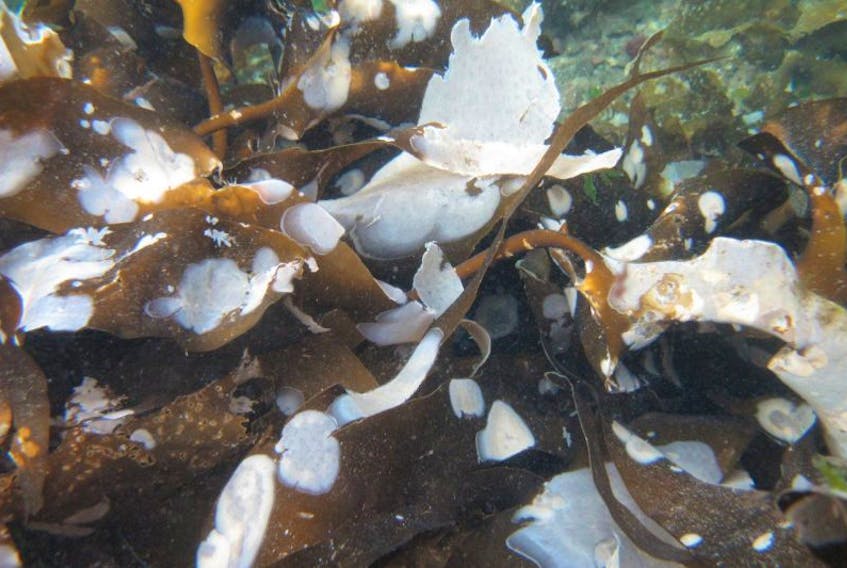It is an invertebrate, a bryozoan, a tiny filter feeder that attaches itself to things in the water and builds up into rough mats, colonies. It’s not exactly welcomed.
“It tends to form very thick crusts on the surface of kelp and these crusts interfere with some key biological aspects of the seaweed,” said Pat Gagnon, with Memorial University of Newfoundland’s department of ocean sciences, who has studied the bryozoan in Newfoundland and Labrador.
Apart from limiting the kelp photosynthesis, it limits its reproduction and, by adding weight to the blades, can result in the seaweed breaking off in heavy waves.
“That’s biomass that’s no longer available for other species that depend on kelp,” he said.
Gagnon mentioned the coffin box when asked about what he sees relating to climate change in Newfoundland and Labrador. The species popped up on the U.S. Atlantic coast, and was recorded in Nova Scotia by the 1990s. A paper published in 2012 in Marine Biology, authored by Gagnon and Scott Caines, addresses the importance of water temperature for its proliferation. The paper followed their examination of kelp samples and temperature readings taken from eight sites, on a north-south range of 450 kilometres along western Newfoundland and the south of Labrador.
RELATED LINKS:
Population dynamics of the invasive bryozoan Membranipora membranacea along a 450-km latitudinal range in the subarctic northwestern Atlantic
Nature Conservancy of Canada — Invasive Species Gallery
Tsunami-driven rafting: Transoceanic species dispersal and implications for marine biogeography
“You only really need to have an idea of the temperature profile at one site to be able to predict how much of that bryozoan you get on the kelp. So there’s a very strong relationship between the temperature and the abundance,” Gagnon said.
Despite its name, despite its presence here after having already destroyed entire kelp forests in the Gulf of Maine, according to the Department of Fisheries and Oceans, Gagnon doesn’t talk about the coffin box as being good or bad. They just are.
If the temperature is right and they can spread and colonize, they will.
“It is expected that ocean warming will trigger range expansion in many marine invertebrate. Therefore, a corollary hypothesis is that kelp habitats at the southern and northern tips of Newfoundland and in Labrador will be increasingly at risk as sea temperature continues to rise and growth conditions become more favourable for Membranipora membranacea,” the paper stated.
•••
Looking to land, the Nature Conservancy of Canada (NCC) maintains a gallery of invasive species to Canada.
NCC national conservation biologist Dan Kraus said not all invasive species are a nuisance or harmful, but some are. And plenty are already here to stay.
“Probably one of the best things we can do is, first of all, use it as a lesson and think about how they got here and how we can keep others from coming in,” Kraus said.
The awareness is even more important, he suggested, as climate change affects longstanding natural barriers, like the one keeping kudzu — “the vine that ate the South” — from invading.
A patch was spotted in southern Ontario in 2009.
“It can grow very rapidly and take over huge areas and it hadn’t been able to grow in Canada because of our winters, but there’s an example of a plant where, because of warming climate, it could start to get established,” he said. “There’s actually quite a few species like that, where using cold against an invasive species maybe isn’t as effective as it used to be in Canada.”
With improved regulations around everything from ballast water to nursery plants, Kraus said there is general improvement in preventative measures against new invaders.
However, individuals should be aware their own efforts can make a difference. He pointed to an aggressive response by government after report of a snakehead fish in a pond in British Columbia and the program in Ontario to eradicate the Asian longhorned beetle.
“I think climate change, it means we really have to double down on our vigilance,” Kraus said. “So having an informed public out there so when they see something they can hopefully help identify and report it, so we can manage it quickly.”
He recommended trying the app iNaturalist (iNaturalist.org) to help identify and map species you spot, all with the snap of a picture.
But there are species already arrived where disruption will have to be managed.









